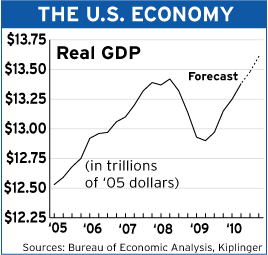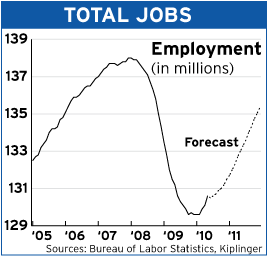Where the Economy Is Headed
Stronger business spending and rising employment will help this recovery shake off worries about Europe.

Since the U.S. economy pulled out of a tailspin a year ago, upward propulsion has been modest, with tentative employment growth. Now, with Europe teetering on the edge of a financial abyss, worries about contagion are driving down stock prices and sending investors scurrying to U.S. Treasuries. Rumblings about the prospect of a double-dip recession are resurfacing.
We think a relapse into recession isn’t likely. Odds are that worries about Europe’s woes infecting the U.S. will recede by year-end as policymakers there do whatever it takes in the short term to prevent a meltdown. Indeed, U.S. GDP will grow about 3.5% this year and the same next. Though that’s far from the 6.3% average growth racked up in postrecession periods since World War II, it’s a decent gain and better than the U.S. saw in the last two recoveries, in 1991 and 2002.
Several factors will help drive the growth: Lean inventories, as businesses, which underestimated the rebound, are forced to restock factory bins and store shelves. Business spending on equipment and software -- fueled by rising profit margins, technology innovations, easing credit and business’s huge cash reserves. The continuation of the federal stimulus package this year, though it scales back sharply in 2011 and will detract from GDP growth then.

Sign up for Kiplinger’s Free E-Newsletters
Profit and prosper with the best of expert advice on investing, taxes, retirement, personal finance and more - straight to your e-mail.
Profit and prosper with the best of expert advice - straight to your e-mail.
In addition, there’ll be a pickup in employment and income. Extraordinary productivity gains over the past year have let firms expand output with minimal hiring. But that path will peter out, and employers will have to add to payrolls to lift production even more. Meanwhile, workers who have jobs are bringing home paychecks that stretch farther. Real hourly wages -- measured after wringing out the effect of a big energy price drop -- have climbed 3.5% since 2007. With inflation likely to remain tame, the erosion in real wages that usually comes with high unemployment will continue to be offset. Rock-bottom interest rates won’t hurt either. With the Federal Reserve more worried about deflation than the opposite, it will keep interest rates at record lows into next year.

Moreover, consumer confidence is on the rise. The most recent University of Michigan monthly reading of 75.5 is nearly halfway between the prerecession mark of 97 and the dismal 55 it hit during the financial crisis. And American’s household net worth is up -- $3.5 trillion from a year ago and $5.8 trillion from its recessionary bottom. Even after accounting for recent market corrections, the S&P 500 is up about 60% from its early 2009 low.
But regaining the robust economic health of a few years ago is still far off, as our new online Economic Health Tracker indicates. For Americans to feel as well off as they did just a few years ago, a variety of other problems must be solved.
Most importantly, there are too many idled resources: Assembly lines operating at less than full speed. Vacant warehouses, factories and storefronts. Mines, utilities and other operations churning out less than before the recession hit. In mid-2009, slightly more than two-thirds of total U.S. industrial capacity was in use. Today, utilization is about 74%, about five percentage points lower than the usual rate when the economy’s thriving, and well below the even higher prerecession rate. And it’s not just manufacturers with spare capacity. Service industries are awash with it as well: Unused equipment at commercial laundries. Lawyers taking pro bono cases to fill their time. Empty chairs at hair and nail salons. And so on.
Millions of people remain out of work. The 980,000 net increase in jobs so far this year only begins to chip away at the 8.4 million jobs lost during the 2008-09 rout. Until more employers are confident the economic recovery is on solid ground, they’ll resist committing to permanent hires. As a result, it will take until late 2012 to recover the lost jobs. Worse, because the labor force is always growing -- with young people seeking first jobs plus immigrants -- the jobless rate won’t sink to a more normal 5.5% again until 2014 or so.

Credit availability also remains far from normal, crimping the ability of private businesses -- especially small firms, which typically account for half of all jobs in the U.S. -- to grow. Under normal conditions, the difference between the share of small companies that say loans are becoming harder to get and the share that say the opposite is no more than about nine points. Today, the difference is 13 percentage points. Tightfisted lenders will eventually loosen up, probably easing standards in the second half of 2010. But for now, huge losses during the Great Recession, uncertainty about financial reform legislation and doubts about the durability of the recovery will restrict credit.
And housing woes need to ease, both because home prices color consumers’ perceptions of their financial well-being, affecting their willingness to spend, and because housing and related industries typically account for 7% of the economy. Making headway when building and sales are stumbling is tough.
The sad fact is, it will take a decade to regain the prerecession highs in construction and sales of new homes. Ditto, home prices, at least in areas that were hardest hit, such as Calif., Fla. and Ariz. That’s mostly because those peaks were artificially high, pumped up by unsound mortgages destined to crumble. It would take three years of annual increases of 3%,followed by three more years of 5% annual gains, for the median home price to match the October 2005 peak.
Indeed, even a return to pre-bubble levels will take years. At 650,000 this year and an expected 900,000 in 2011, housing starts are a long way from 2001’s 1.6 million. New-home sales won’t top half a million until next year and won’t hit 800,000 -- the high end of the normal band in the 1980s and 1990s -- until 2014 or 2015. A slightly less dismal outlook for sales of existing homes: 5.3 million this year and 5.5 million next -- near pre-bubble levels.
Get Kiplinger Today newsletter — free
Profit and prosper with the best of Kiplinger's advice on investing, taxes, retirement, personal finance and much more. Delivered daily. Enter your email in the box and click Sign Me Up.

-
 2026 Disney Dining Plan Returns: Free Dining for Kids & Resort Benefits
2026 Disney Dining Plan Returns: Free Dining for Kids & Resort BenefitsPlan your 2026 Walt Disney World vacation now. Learn about the returning Disney Dining Plan, how kids aged three to nine eat free, and the exclusive benefits of staying at a Disney Resort hotel.
By Carla Ayers
-
 How Can Investors Profit From AI's Energy Use?
How Can Investors Profit From AI's Energy Use?Global energy demand is expected to grow by leaps and bounds over the next several years as AI usage accelerates. Here's how to get a piece of the pie.
By Jacob Schroeder
-
 The Economic Impact of the US-China Trade War
The Economic Impact of the US-China Trade WarThe Letter The US-China trade war will impact US consumers and business. The decoupling process could be messy.
By David Payne
-
 AI Heads to Washington
AI Heads to WashingtonThe Kiplinger Letter There’s big opportunity for AI tools that analyze MRIs and other medical images. But also big challenges that clinicians and companies will have to overcome.
By John Miley
-
 The AI Doctor Coming to Read Your Test Results
The AI Doctor Coming to Read Your Test ResultsThe Kiplinger Letter There’s big opportunity for AI tools that analyze CAT scans, MRIs and other medical images. But there are also big challenges that human clinicians and tech companies will have to overcome.
By John Miley
-
 The New Space Age Takes Off
The New Space Age Takes OffThe Kiplinger Letter From fast broadband to SOS texting, space has never been more embedded in peoples’ lives. The future is even more exciting for rockets, satellites and emerging space tech.
By John Miley
-
 Rising AI Demand Stokes Undersea Investments
Rising AI Demand Stokes Undersea InvestmentsThe Kiplinger Letter As demand soars for AI, there’s a need to transport huge amounts of data across oceans. Tech giants have big plans for new submarine cables, including the longest ever.
By John Miley
-
 What DOGE is Doing Now
What DOGE is Doing NowThe Kiplinger Letter As Musk's DOGE pursues its ambitious agenda, uncertainty and legal challenges are mounting — causing frustration for Trump.
By Matthew Housiaux
-
 A Move Away From Free Trade
A Move Away From Free TradeThe Letter President Trump says long-term gain will be worth short-term pain, but the pain could be significant this year.
By David Payne
-
 Trump’s Whirlwind Month of Crypto Moves
Trump’s Whirlwind Month of Crypto MovesThe Kiplinger Letter The Trump administration wants to strengthen U.S. leadership in the cryptocurrency industry by providing regulatory clarity.
By Rodrigo Sermeño